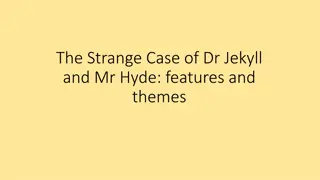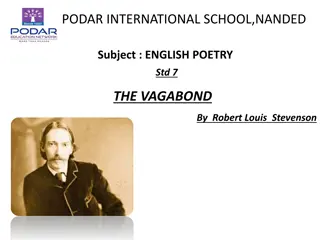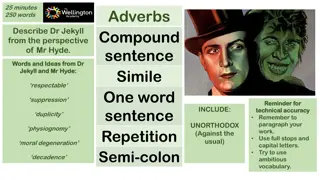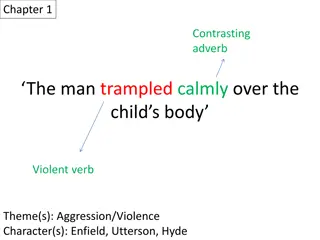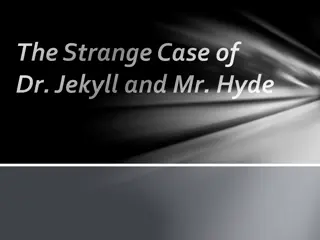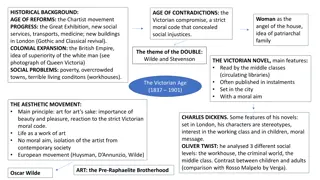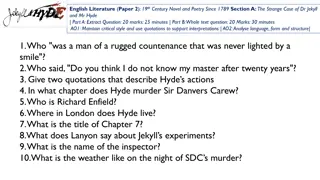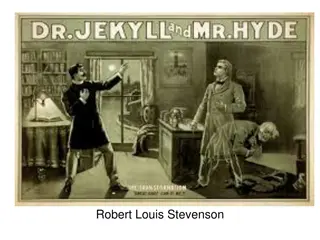Understanding Context in Jekyll and Hyde: Victorian Britain and Robert Louis Stevenson
Explore the social, economic, and moral landscape of Victorian Britain as reflected in Robert Louis Stevenson's life and novella, "Strange Case of Dr Jekyll and Mr Hyde." Delve into the dual nature of Victorian cities, core values, views on crime and morality, religious influences, and the significance of Darwin's theory of evolution. Discover how Stevenson's personal struggles with health and his interest in human nature shaped his writing.
Download Presentation

Please find below an Image/Link to download the presentation.
The content on the website is provided AS IS for your information and personal use only. It may not be sold, licensed, or shared on other websites without obtaining consent from the author. Download presentation by click this link. If you encounter any issues during the download, it is possible that the publisher has removed the file from their server.
E N D
Presentation Transcript
Jekyll and Hyde Jekyll and Hyde Context Revision Starter: What specific and relevant aspects of context can you remember? What can you remember about Victorian Britain? What can you dual nature of the main Victorian Cities? What were the core Victorian values? What did the Victorians think about crime and morality? What are the core religious messages important for the novella? Which genres could it be placed in? What are the conventions of this genre? What is the significance of Darwin s theory of evolution? Prompts What developments were made in Science and technology at this time? How did this fit in with ideas about religion at the time? What can you remember about Stevenson s life and the impact of his early life on his writing?
Robert Louis Stevenson -1850-1894 Scottish essayist, poet, and author of fiction and travel books Many of his stories have horror and supernatural elements His characters often prefer unknown hazards to everyday life of Victorian society. Gained first fame with the romantic adventure story Treasure Island (a combination of travel adventure and romance) He was not a well man, and from childhood suffered with tuberculosis. During his early years, he spent much of his time in bed, composing stories before he had learned to read. In an attempt to improve his health, Stevenson travelled on the Continent and in the Scottish Highland. These trips provided him with many insights and inspiration for his writing. He died of a brain hemorrhage on December 3, 1894 Stevenson was interested in what made up a person s character: why they could be bad as well as good. He came from a good family but he was fascinated by the "dregs of humanity", something that the upper class pretended never existed. After a nightmare, Stevenson wrote the story of Dr. Jekyll in just three days
Victorian Britain Key Notes Victorian Britain was becoming more and more prosperous through industrialisation, however its cities were also starkly polarised with large areas of great poverty and squalor rife with disease. There was a considerable lack of equality for the working classes, especially women, including a lack of education Crime, drug abuse and prostitution were increasing problems in the major cities, as demonstrated through Soho in the novella. Governments didn t invest in welfare and the church was criticised for its lack of compassion and genuine help.
Victorian Britain Links to J&H Stevenson s novella presents an image of wealthy professional people who either condemn or ignore the issue of poverty, vice and suffering. However, in Jekyll, we see that the portrayal was often inaccurate and the hypocrisy of the middle to upper classes. It could be suggested that this was also the life of the typical reader of Stevenson s fiction and therefore he is also critical of their attitudes and hypocrisy. Through Jekyll s transformation into Hyde, the reader is forced to see the underbelly of city life, and the hypocrisy of those who deny its existence. Stevenson doesn t focus on how these issues are to be solved. Instead he focuses on why people indulge in vice and that it shouldn t be ignored.
Victorian Values Victorian values were a strict moral and social code rigid beliefs about how people should live their lives. There is however, a stark contrast often in how people believed people should behave and the reality. Reputation was highly valued in Victorian society it was essential to be considered moral and worthy. As part of this appearance became greatly important, it was also significant that the study of physiognomy and phrenology (the belief that you could understand someone s value by their appearance) was important at the time. Christianity and regular attendance at church linked to Victorian values, as well as a belief that moderation in all things was important. Repression was important, and significant for the novella as many Victorian men lived almost a double life. They appeared proper but would secretly indulge in vices such as prostitution, gambling and drug abuse.
Victorian Values links to J&H Utterson is used by Stevenson to portray the characteristics of a good Victorian . He has a strict moral code, is charitable to others, seemingly restrained in his enjoyments and worries about the reputation of his friends. Dr Jekyll is almost the antithesis of Jekyll. He is used by Stevenson to demonstrate the darker side of the Victorian era: a well respected professional man who hides a violent and corrupt nature. Stevenson suggests through Jekyll s final confession, that all of humankind has a dual nature that includes unpleasant characteristics.
Science, Evolution and Physiognomy The nineteenth century saw many advances in chemistry and biology, with new and important discoveries, chemicals identified and developments made. Charles Darwin s theory of evolution was explained in his 1859 text, The Origin of the Species . Widely seen as controversial, it was seen to contradict and conflict with religious teaching. Stevenson makes use of the popular and completely unscientific belief in physiognomy. The pseudoscience asserted that a person s character and personality could be assessed from their outward appearance, particularly the face. This also links with the importance of appearance.
Science, Evolution and Physiognomy links to J&H Stevenson relates the developments in Modern Science to make Jekyll s transformation into Hyde seem more realistic. Although Stevenson makes no direct reference to it, Dr Jekyll can be seen to be the effect of Darwinism. He questions established ideas about humanity and the natural world and wishes to tamper with what a contemporary reader would consider God s creation. Stevenson also draws on evolution when describing Hyde: animal imagery is used throughout in connection to him ape like fury , a masked thing like a monkey . One of the key ways in which Hyde is established as a character is in the other character s impressions that he is evil due to his appearance. The novel is full of descriptions of Hyde s strange looks.
Gothic Genre The novel was a modern version of the traditional gothic genre, describing strange events in a contemporary urban nineteenth century setting. Stevenson s 1886 novel has sinister settings but are contemporary rather than the traditional castles. Similarly the strange and frightening events are linked to science and technology rather than the supernatural. Stevenson focuses on mystery and hoe the theme of duality could explore modern Victorian identity and attitudes.
Other genres? There are also aspects of detective fiction, another popular genre of the period (the first Sherlock Holmes novel was published in 1887). Mr Utterson sets forth the mystery of Hyde: there is a murder case, different clues and evidence pieced together, the possibility of blackmail and even works with the police in chapter 4. In addition through the fantastical exploration of scientific advances, the novel can be seen as using elements of the emerging science fiction genre. Stevenson s novel can also be placed in a genre known as fin de si cle (meaning end of the century). This was an idea that as the new century loomed, society had become more decadent and degenerate. A series of nineteenth century noels explored the evolution, corruption and anxiety about the state of humanity.
Religion Jekyll and Hyde is perhaps an allegory for the fall of mankind posing existential questions that are timeless. Biblical existentialism is consistently referred to throughout the novel; particular issues of apotheosis Jekyll and Hyde has 10 chapters: these could represent Stevenson s ten commandments for societies. Do not play God: science can take us nowhere in issues of morality. The whole story is an allegory for Cain and Abel eventually God would flood the world. What hope does Stevenson have then? Chapter 10 is Jekyll s confession before he leaves the world. The story explains the fall of mankind and original sin gives explanations to Christians for the state of the world. In many ways Stevenson sacrifices Jekyll like Jesus to save the world by giving us Jekyll s message.
Links to exam practice This extract from chapter 1, describes the side entrance to Dr Jekyll s house that is used by Mr Hyde. Write a SQuAD in response to the question: How does Stevenson present some of Britain s social issues in the extract?






